How To Draw A Real Panda
Lookout man Now This tutorial has a related video course created by the Real Python team. Watch it together with the written tutorial to deepen your understanding: Plot With Pandas: Python Data Visualization Nuts
Whether y'all're just getting to know a dataset or preparing to publish your findings, visualization is an essential tool. Python'south pop data analysis library, pandas, provides several different options for visualizing your data with .plot(). Even if you lot're at the starting time of your pandas journeying, you'll soon be creating basic plots that will yield valuable insights into your information.
In this tutorial, you'll learn:
- What the unlike types of pandas plots are and when to use them
- How to become an overview of your dataset with a histogram
- How to find correlation with a scatter plot
- How to analyze unlike categories and their ratios
Set up Your Environment
You can best follow forth with the code in this tutorial in a Jupyter Notebook. This way, yous'll immediately see your plots and be able to play around with them.
You'll also demand a working Python surroundings including pandas. If you lot don't have one yet, and then you lot have several options:
-
If you have more ambitious plans, then download the Anaconda distribution. It's huge (effectually 500 MB), merely you'll exist equipped for most information scientific discipline work.
-
If you prefer a minimalist setup, then check out the section on installing Miniconda in Setting Upward Python for Machine Learning on Windows.
-
If you want to stick to
pip, then install the libraries discussed in this tutorial withpip install pandas matplotlib. You tin also catch Jupyter Notebook withpip install jupyterlab. -
If you don't desire to do whatsoever setup, and so follow forth in an online Jupyter Notebook trial.
Once your environment is set up, you're ready to download a dataset. In this tutorial, you're going to clarify information on higher majors sourced from the American Community Survey 2010–2012 Public Utilize Microdata Sample. Information technology served as the ground for the Economic Guide To Picking A College Major featured on the website FiveThirtyEight.
First, download the data past passing the download URL to pandas.read_csv():
>>>
In [1]: import pandas as pd In [2]: download_url = ( ...: "https://raw.githubusercontent.com/fivethirtyeight/" ...: "data/master/college-majors/recent-grads.csv" ...: ) In [3]: df = pd . read_csv ( download_url ) In [4]: type ( df ) Out[4]: pandas.core.frame.DataFrame By calling read_csv(), you create a DataFrame, which is the main data construction used in pandas.
At present that you have a DataFrame, you can take a look at the data. Outset, y'all should configure the display.max.columns choice to brand certain pandas doesn't hide any columns. Then yous can view the first few rows of data with .head():
>>>
In [5]: pd . set_option ( "display.max.columns" , None ) In [6]: df . head () You've just displayed the first v rows of the DataFrame df using .caput(). Your output should look like this:

The default number of rows displayed past .head() is 5, but y'all can specify any number of rows every bit an argument. For example, to display the first x rows, you would utilise df.head(10).
Create Your First Pandas Plot
Your dataset contains some columns related to the earnings of graduates in each major:
-
"Median"is the median earnings of full-time, year-round workers. -
"P25th"is the 25th percentile of earnings. -
"P75th"is the 75th percentile of earnings. -
"Rank"is the major'south rank by median earnings.
Allow'due south start with a plot displaying these columns. First, you demand to fix upward your Jupyter Notebook to display plots with the %matplotlib magic command:
>>>
In [7]: % matplotlib Using matplotlib backend: MacOSX The %matplotlib magic command sets up your Jupyter Notebook for displaying plots with Matplotlib. The standard Matplotlib graphics backend is used by default, and your plots will be displayed in a split up window.
Now you lot're ready to brand your get-go plot! Yous tin do so with .plot():
>>>
In [8]: df . plot ( x = "Rank" , y = [ "P25th" , "Median" , "P75th" ]) Out[8]: <AxesSubplot:xlabel='Rank'> .plot() returns a line graph containing data from every row in the DataFrame. The x-axis values represent the rank of each institution, and the "P25th", "Median", and "P75th" values are plotted on the y-axis.
The effigy produced by .plot() is displayed in a separate window past default and looks like this:
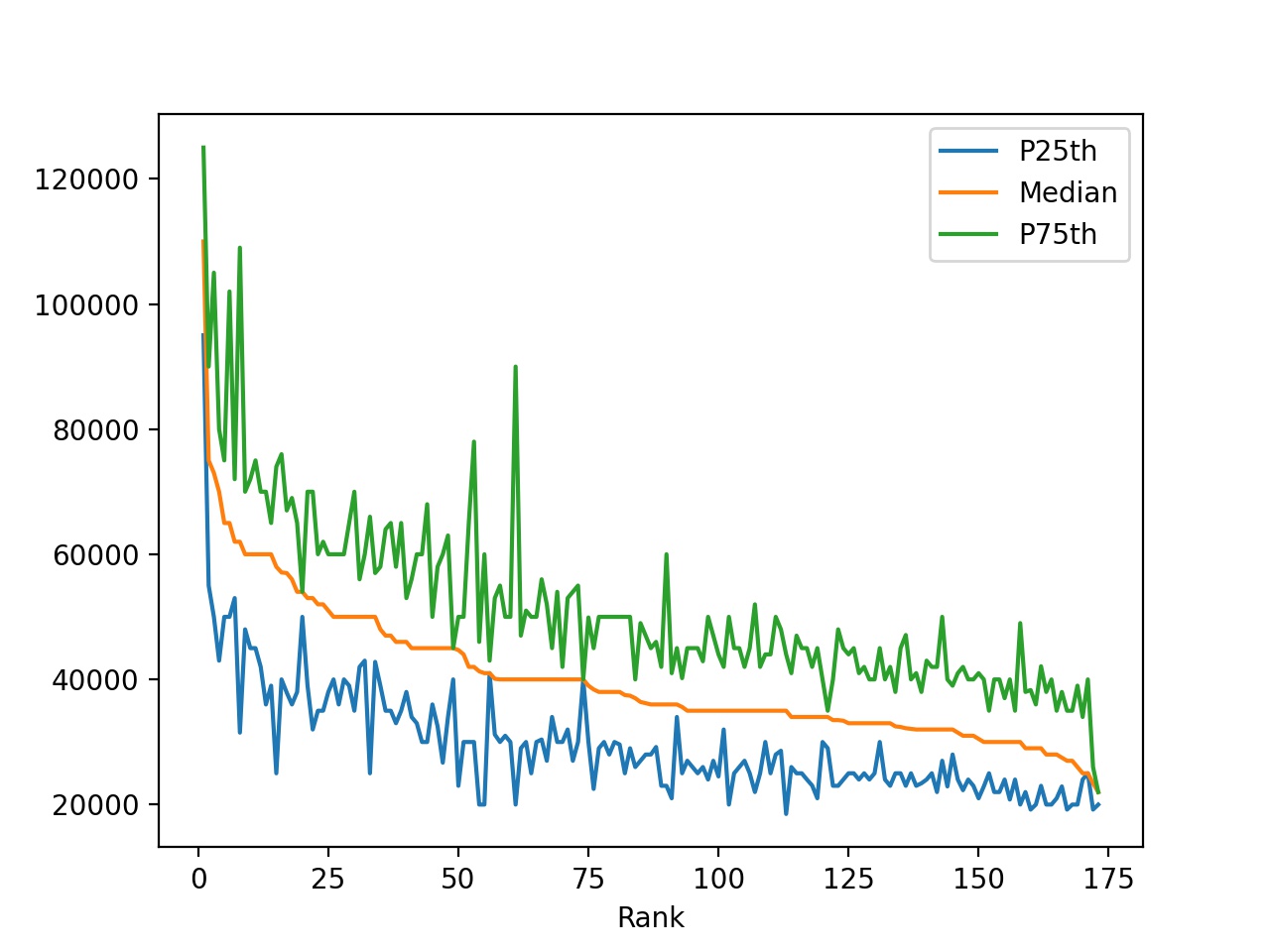
Looking at the plot, you can make the post-obit observations:
-
The median income decreases as rank decreases. This is expected because the rank is determined by the median income.
-
Some majors have large gaps betwixt the 25th and 75th percentiles. People with these degrees may earn significantly less or significantly more than than the median income.
-
Other majors take very small gaps betwixt the 25th and 75th percentiles. People with these degrees earn salaries very close to the median income.
Your first plot already hints that in that location's a lot more to discover in the data! Some majors have a wide range of earnings, and others have a rather narrow range. To discover these differences, you'll use several other types of plots.
.plot() has several optional parameters. Most notably, the kind parameter accepts eleven different string values and determines which kind of plot you'll create:
-
"surface area"is for area plots. -
"bar"is for vertical bar charts. -
"barh"is for horizontal bar charts. -
"box"is for box plots. -
"hexbin"is for hexbin plots. -
"hist"is for histograms. -
"kde"is for kernel density judge charts. -
"density"is an allonym for"kde". -
"line"is for line graphs. -
"pie"is for pie charts. -
"scatter"is for scatter plots.
The default value is "line". Line graphs, like the 1 you created above, provide a good overview of your data. You can use them to detect general trends. They rarely provide sophisticated insight, but they tin can give you clues equally to where to zoom in.
If y'all don't provide a parameter to .plot(), and then it creates a line plot with the alphabetize on the x-axis and all the numeric columns on the y-axis. While this is a useful default for datasets with but a few columns, for the higher majors dataset and its several numeric columns, it looks like quite a mess.
Now that you've created your first pandas plot, allow's take a closer wait at how .plot() works.
Look Under the Hood: Matplotlib
When you call .plot() on a DataFrame object, Matplotlib creates the plot nether the hood.
To verify this, try out two code snippets. First, create a plot with Matplotlib using two columns of your DataFrame:
>>>
In [9]: import matplotlib.pyplot as plt In [10]: plt . plot ( df [ "Rank" ], df [ "P75th" ]) Out[x]: [<matplotlib.lines.Line2D at 0x7f859928fbb0>] Kickoff, you import the matplotlib.pyplot module and rename it to plt. So you call plot() and laissez passer the DataFrame object's "Rank" cavalcade as the start argument and the "P75th" cavalcade equally the second argument.
The issue is a line graph that plots the 75th percentile on the y-centrality against the rank on the x-axis:
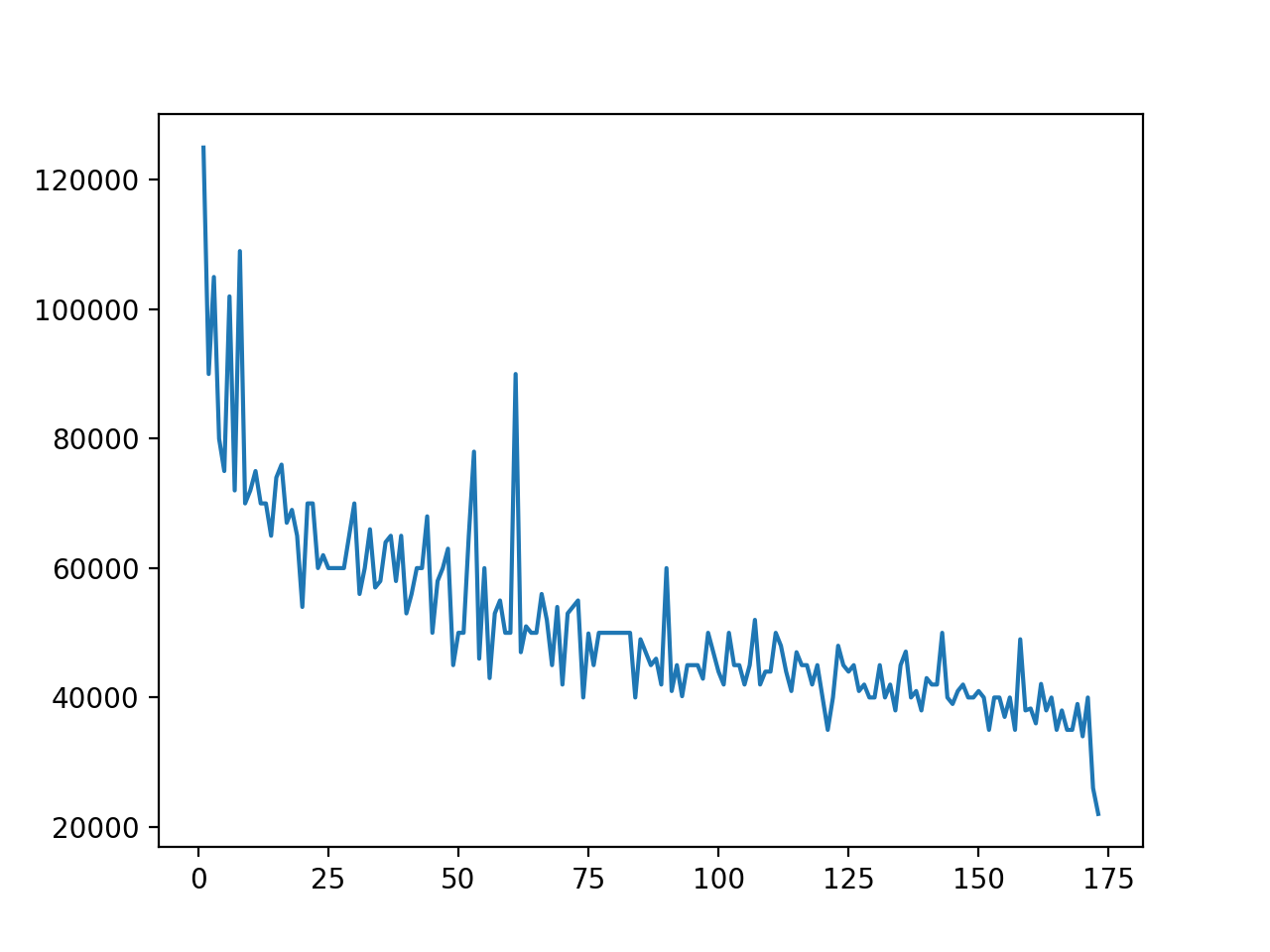
You can create exactly the same graph using the DataFrame object'due south .plot() method:
>>>
In [eleven]: df . plot ( x = "Rank" , y = "P75th" ) Out[xi]: <AxesSubplot:xlabel='Rank'> .plot() is a wrapper for pyplot.plot(), and the outcome is a graph identical to the i you produced with Matplotlib:

You lot tin can utilise both pyplot.plot() and df.plot() to produce the same graph from columns of a DataFrame object. Notwithstanding, if you already have a DataFrame instance, then df.plot() offers cleaner syntax than pyplot.plot().
Now that you know that the DataFrame object's .plot() method is a wrapper for Matplotlib's pyplot.plot(), let'due south dive into the unlike kinds of plots you lot tin can create and how to make them.
Survey Your Data
The next plots volition give you a general overview of a specific column of your dataset. Commencement, you'll have a await at the distribution of a property with a histogram. And so y'all'll get to know some tools to examine the outliers.
Distributions and Histograms
DataFrame is not the only class in pandas with a .plot() method. As so often happens in pandas, the Serial object provides similar functionality.
You can get each column of a DataFrame as a Series object. Hither's an example using the "Median" column of the DataFrame you created from the college major information:
>>>
In [12]: median_column = df [ "Median" ] In [thirteen]: type ( median_column ) Out[13]: pandas.cadre.serial.Series Now that you take a Series object, you can create a plot for information technology. A histogram is a good way to visualize how values are distributed beyond a dataset. Histograms group values into bins and brandish a count of the information points whose values are in a particular bin.
Permit'south create a histogram for the "Median" column:
>>>
In [14]: median_column . plot ( kind = "hist" ) Out[xiv]: <AxesSubplot:ylabel='Frequency'> You call .plot() on the median_column Series and pass the cord "hist" to the kind parameter. That's all at that place is to it!
When you call .plot(), you lot'll run into the post-obit figure:
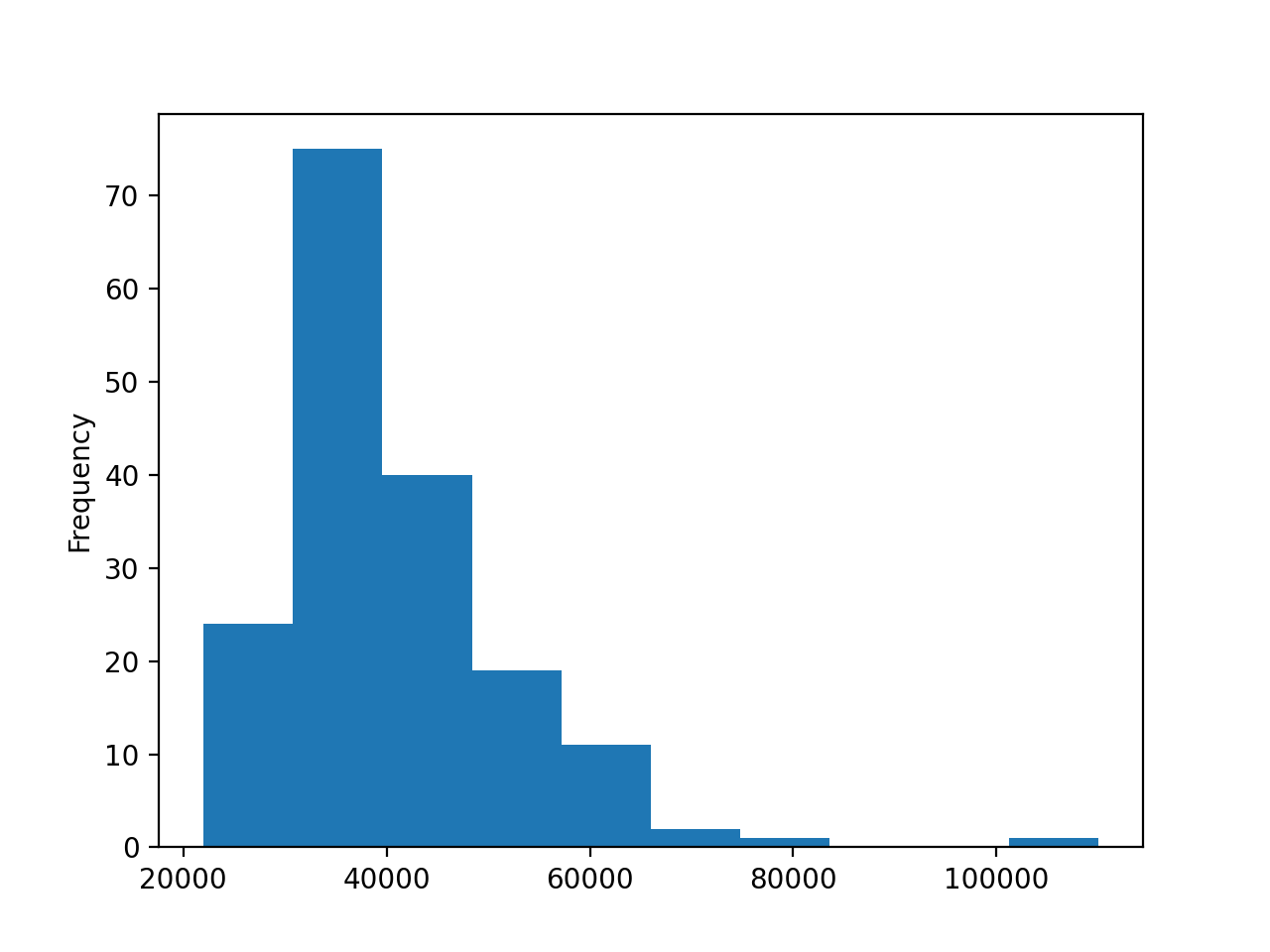
The histogram shows the data grouped into ten bins ranging from $20,000 to $120,000, and each bin has a width of $10,000. The histogram has a different shape than the normal distribution, which has a symmetric bell shape with a peak in the middle.
The histogram of the median data, still, peaks on the left beneath $forty,000. The tail stretches far to the right and suggests that there are indeed fields whose majors can expect significantly higher earnings.
Outliers
Have you spotted that solitary minor bin on the right edge of the distribution? It seems that one data indicate has its own category. The majors in this field go an fantabulous salary compared not only to the boilerplate just also to the runner-upwards. Although this isn't its primary purpose, a histogram can assist yous to detect such an outlier. Allow'south investigate the outlier a bit more:
- Which majors does this outlier correspond?
- How big is its edge?
Contrary to the beginning overview, you but desire to compare a few data points, but yous desire to meet more details about them. For this, a bar plot is an excellent tool. Showtime, select the v majors with the highest median earnings. You'll need two steps:
- To sort by the
"Median"column, use.sort_values()and provide the name of the column yous want to sort by likewise as the managementascending=False. - To get the top v items of your list, use
.head().
Let's create a new DataFrame called top_5:
>>>
In [xv]: top_5 = df . sort_values ( by = "Median" , ascending = False ) . head () At present you have a smaller DataFrame containing only the summit v most lucrative majors. As a next step, you can create a bar plot that shows simply the majors with these top five median salaries:
>>>
In [16]: top_5 . plot ( x = "Major" , y = "Median" , kind = "bar" , rot = v , fontsize = four ) Out[16]: <AxesSubplot:xlabel='Major'> Observe that you use the rot and fontsize parameters to rotate and size the labels of the x-axis so that they're visible. You'll encounter a plot with v bars:
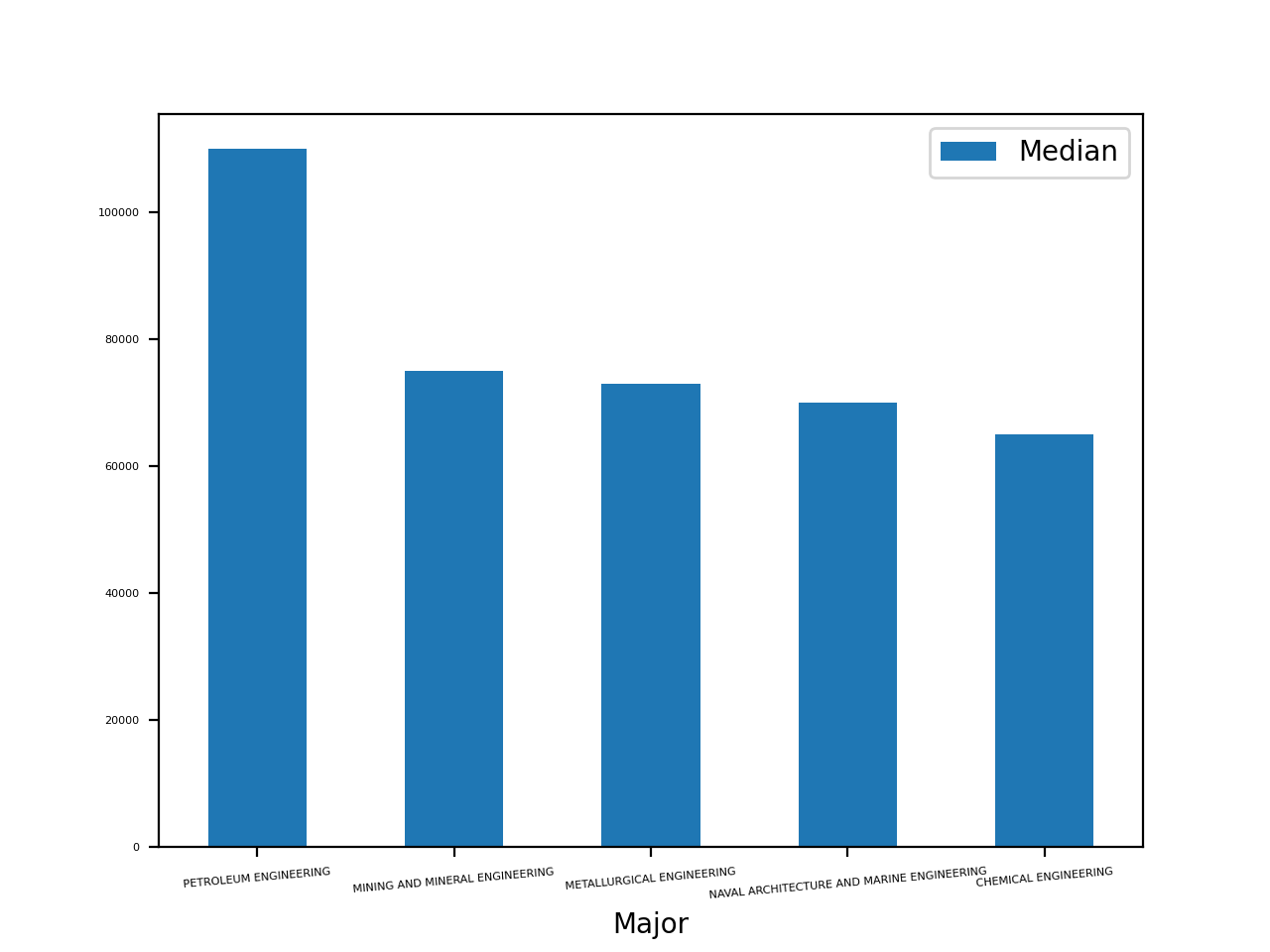
This plot shows that the median bacon of petroleum engineering majors is more than than $twenty,000 higher than the remainder. The earnings for the second- through fourth-identify majors are relatively close to one another.
If you have a data point with a much higher or lower value than the residue, and so yous'll probably want to investigate a bit further. For case, you tin await at the columns that comprise related information.
Let'southward investigate all majors whose median salary is in a higher place $60,000. First, you need to filter these majors with the mask df[df["Median"] > 60000]. Then you tin create another bar plot showing all 3 earnings columns:
>>>
In [17]: top_medians = df [ df [ "Median" ] > 60000 ] . sort_values ( "Median" ) In [18]: top_medians . plot ( x = "Major" , y = [ "P25th" , "Median" , "P75th" ], kind = "bar" ) Out[18]: <AxesSubplot:xlabel='Major'> You should run into a plot with three bars per major, like this:
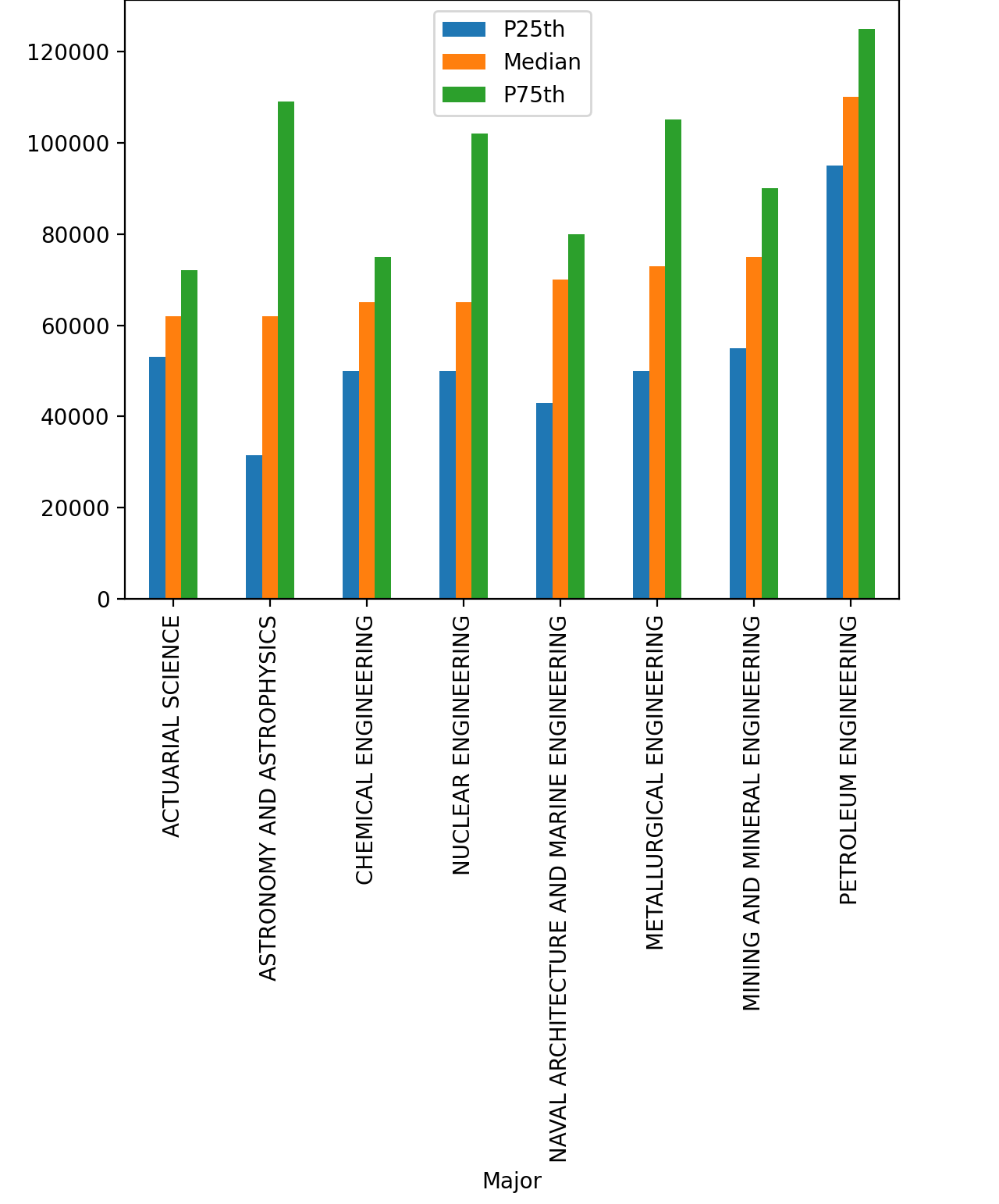
The 25th and 75th percentile confirm what you've seen higher up: petroleum engineering majors were past far the best paid recent graduates.
Why should you be then interested in outliers in this dataset? If you're a college student pondering which major to choice, you lot accept at to the lowest degree one pretty obvious reason. Only outliers are also very interesting from an assay indicate of view. They can signal not just industries with an abundance of money but besides invalid data.
Invalid information tin can be acquired by any number of errors or oversights, including a sensor outage, an error during the manual data entry, or a five-year-old participating in a focus group meant for kids age ten and above. Investigating outliers is an of import pace in information cleaning.
Even if the information is correct, yous may decide that it's merely so different from the rest that it produces more than noise than benefit. Permit'due south assume you analyze the sales information of a small publisher. You group the revenues by region and compare them to the same month of the previous year. And then out of the blue, the publisher lands a national bestseller.
This pleasant event makes your report kind of pointless. With the bestseller'southward data included, sales are going upwardly everywhere. Performing the aforementioned analysis without the outlier would provide more valuable information, allowing yous to come across that in New York your sales numbers take improved significantly, but in Miami they got worse.
Bank check for Correlation
Oft you want to see whether ii columns of a dataset are connected. If you lot pick a major with higher median earnings, do you lot as well have a lower run a risk of unemployment? As a first pace, create a scatter plot with those ii columns:
>>>
In [19]: df . plot ( x = "Median" , y = "Unemployment_rate" , kind = "scatter" ) Out[19]: <AxesSubplot:xlabel='Median', ylabel='Unemployment_rate'> You should run across a quite random-looking plot, like this:
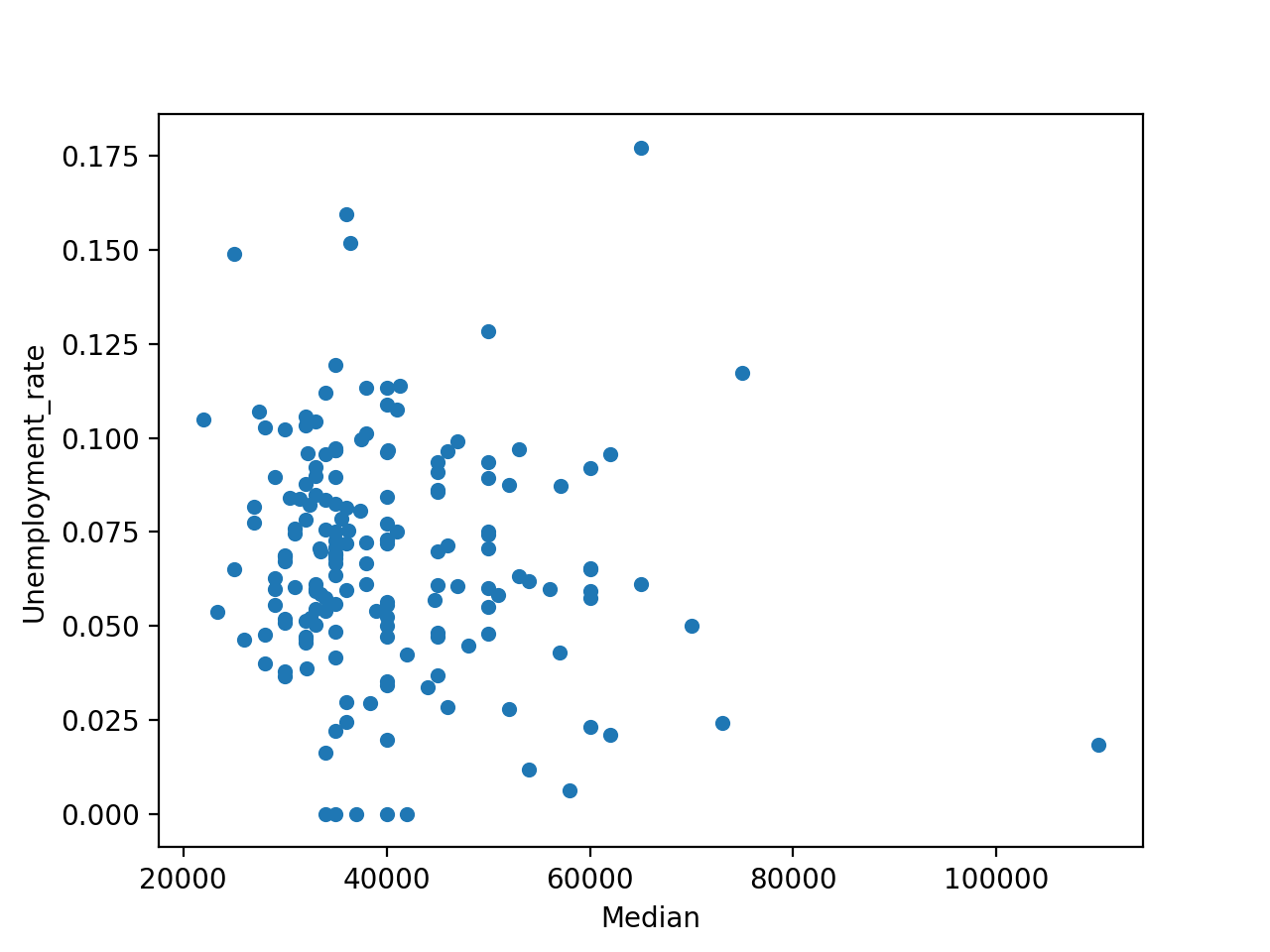
A quick glance at this effigy shows that at that place's no significant correlation between the earnings and unemployment rate.
While a scatter plot is an fantabulous tool for getting a outset impression well-nigh possible correlation, information technology certainly isn't definitive proof of a connexion. For an overview of the correlations between different columns, you can use .corr(). If you suspect a correlation betwixt 2 values, then you accept several tools at your disposal to verify your hunch and measure how strong the correlation is.
Continue in listen, though, that even if a correlation exists betwixt two values, it however doesn't mean that a change in i would effect in a change in the other. In other words, correlation does not imply causation.
Clarify Chiselled Data
To process bigger chunks of information, the human mind consciously and unconsciously sorts data into categories. This technique is frequently useful, but information technology'southward far from flawless.
Sometimes nosotros put things into a category that, upon farther examination, aren't all that similar. In this section, you'll get to know some tools for examining categories and verifying whether a given categorization makes sense.
Many datasets already contain some explicit or implicit categorization. In the current instance, the 173 majors are divided into sixteen categories.
Grouping
A basic usage of categories is group and assemblage. You tin can employ .groupby() to make up one's mind how popular each of the categories in the college major dataset are:
>>>
In [20]: cat_totals = df . groupby ( "Major_category" )[ "Full" ] . sum () . sort_values () In [21]: cat_totals Out[21]: Major_category Interdisciplinary 12296.0 Agriculture & Natural Resources 75620.0 Constabulary & Public Policy 179107.0 Concrete Sciences 185479.0 Industrial Arts & Consumer Services 229792.0 Computers & Mathematics 299008.0 Arts 357130.0 Communications & Journalism 392601.0 Biology & Life Scientific discipline 453862.0 Health 463230.0 Psychology & Social Piece of work 481007.0 Social Science 529966.0 Applied science 537583.0 Educational activity 559129.0 Humanities & Liberal Arts 713468.0 Business 1302376.0 Proper noun: Total, dtype: float64 With .groupby(), you create a DataFrameGroupBy object. With .sum(), you lot create a Series.
Let'south draw a horizontal bar plot showing all the category totals in cat_totals:
>>>
In [22]: cat_totals . plot ( kind = "barh" , fontsize = four ) Out[22]: <AxesSubplot:ylabel='Major_category'> You should meet a plot with one horizontal bar for each category:
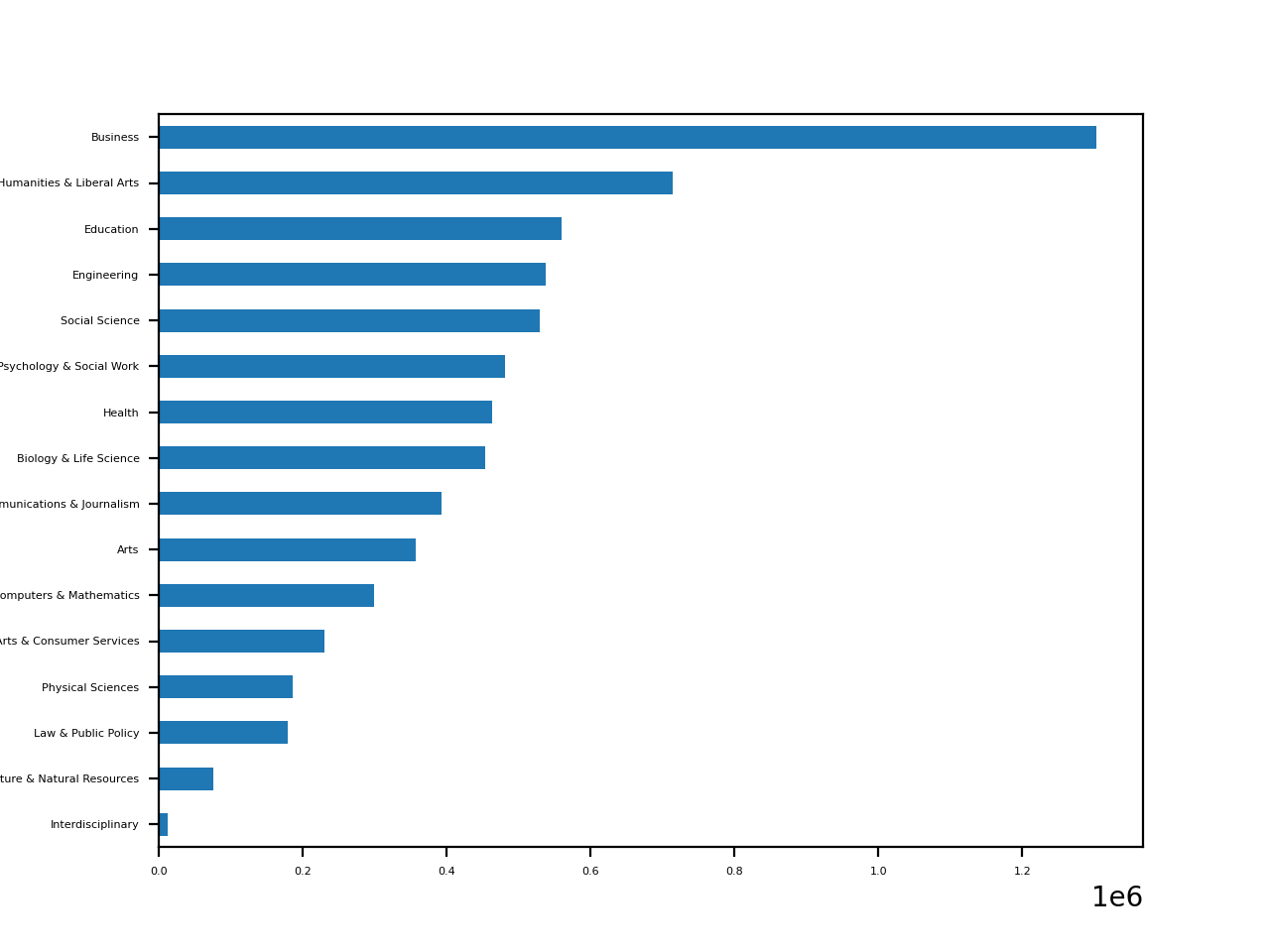
As your plot shows, business is by far the near popular major category. While humanities and liberal arts is the clear second, the rest of the fields are more than similar in popularity.
Determining Ratios
Vertical and horizontal bar charts are oft a good pick if y'all want to meet the departure betwixt your categories. If you lot're interested in ratios, then pie plots are an excellent tool. Nonetheless, since cat_totals contains a few smaller categories, creating a pie plot with cat_totals.plot(kind="pie") will produce several tiny slices with overlapping labels .
To accost this problem, you lot can lump the smaller categories into a unmarried group. Merge all categories with a full under 100,000 into a category called "Other", and then create a pie plot:
>>>
In [23]: small_cat_totals = cat_totals [ cat_totals < 100_000 ] In [24]: big_cat_totals = cat_totals [ cat_totals > 100_000 ] In [25]: # Calculation a new item "Other" with the sum of the small categories In [26]: small_sums = pd . Series ([ small_cat_totals . sum ()], index = [ "Other" ]) In [27]: big_cat_totals = big_cat_totals . append ( small_sums ) In [28]: big_cat_totals . plot ( kind = "pie" , label = "" ) Out[28]: <AxesSubplot:> Notice that you include the argument characterization="". Past default, pandas adds a label with the cavalcade name. That often makes sense, but in this case it would only add racket.
Now you should see a pie plot like this:
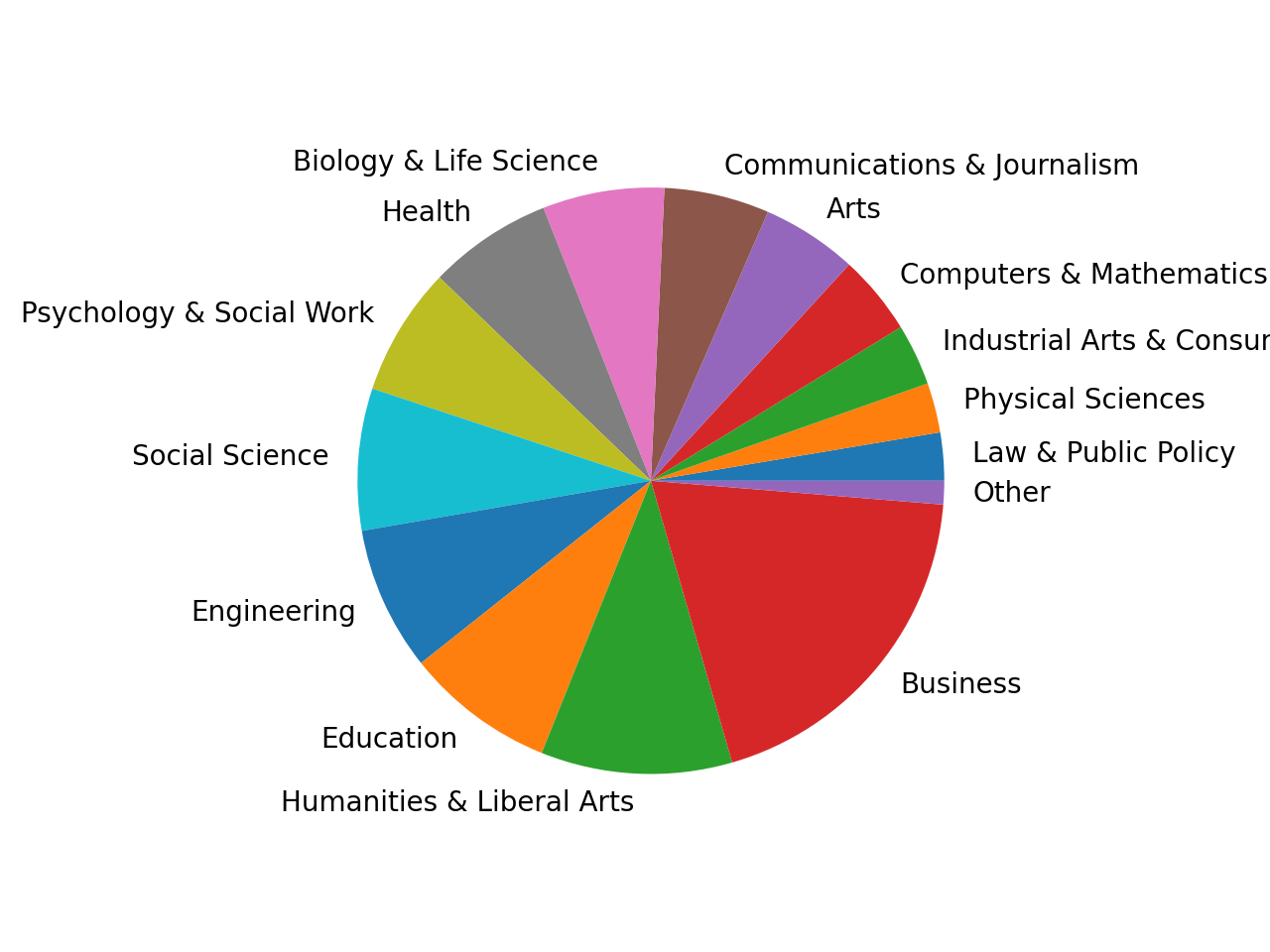
The "Other" category notwithstanding makes up just a very minor slice of the pie. That's a skilful sign that merging those pocket-sized categories was the right option.
Zooming in on Categories
Sometimes you also want to verify whether a certain categorization makes sense. Are the members of a category more similar to one other than they are to the residuum of the dataset? Again, a distribution is a good tool to get a first overview. Generally, we await the distribution of a category to be similar to the normal distribution but have a smaller range.
Create a histogram plot showing the distribution of the median earnings for the applied science majors:
>>>
In [29]: df [ df [ "Major_category" ] == "Engineering" ][ "Median" ] . plot ( kind = "hist" ) Out[29]: <AxesSubplot:ylabel='Frequency'> You'll get a histogram that you tin can compare to the histogram of all majors from the beginning:
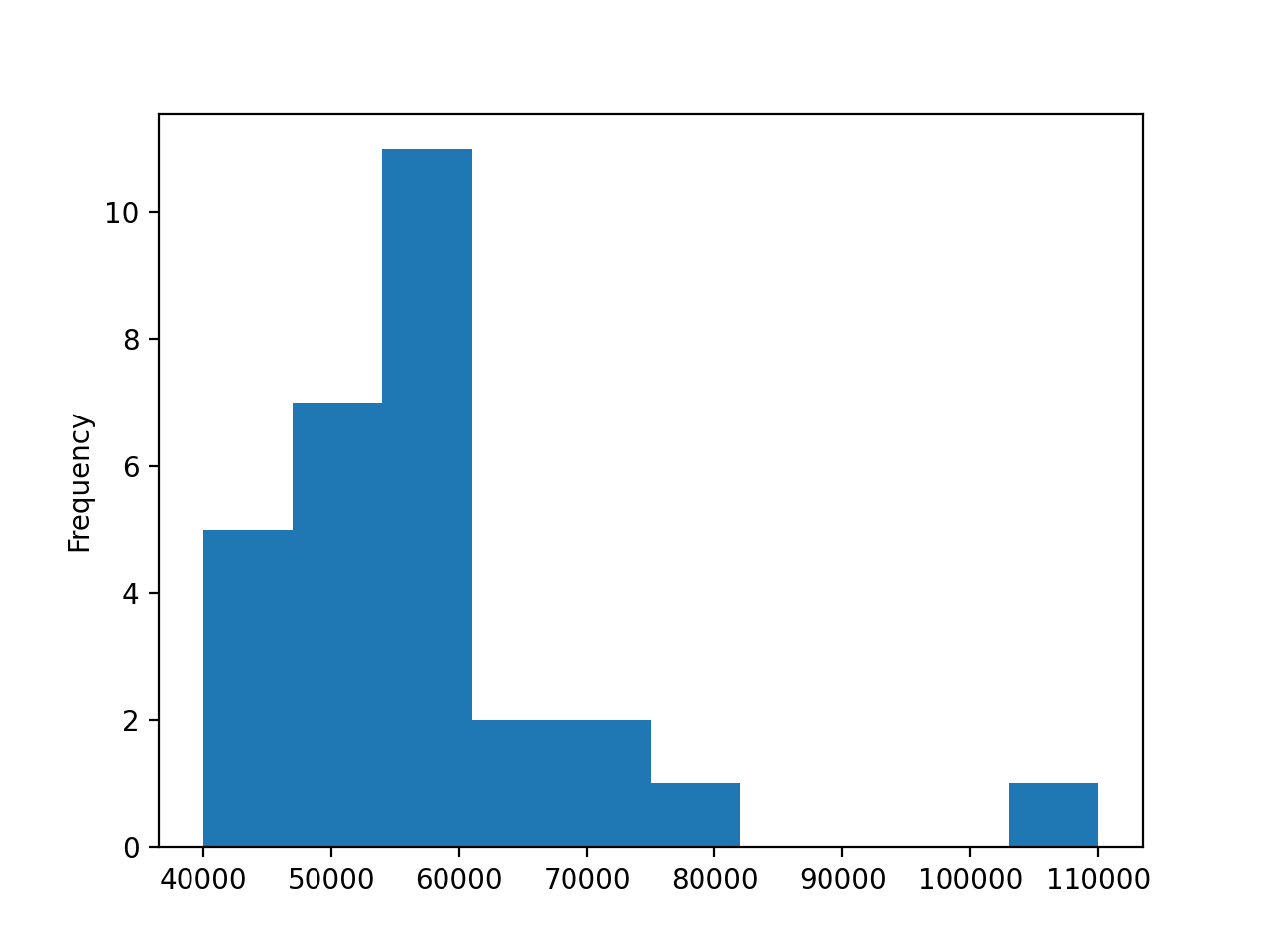
The range of the major median earnings is somewhat smaller, starting at $forty,000. The distribution is closer to normal, although its peak is yet on the left. So, even if you lot've decided to pick a major in the engineering category, it would be wise to dive deeper and clarify your options more than thoroughly.
Conclusion
In this tutorial, you've learned how to start visualizing your dataset using Python and the pandas library. Y'all've seen how some basic plots can give yous insight into your data and guide your assay.
In this tutorial, you learned how to:
- Get an overview of your dataset'southward distribution with a histogram
- Discover correlation with a scatter plot
- Analyze categories with bar plots and their ratios with pie plots
- Make up one's mind which plot is well-nigh suited to your current task
Using .plot() and a minor DataFrame, you lot've discovered quite a few possibilities for providing a picture of your data. You lot're at present gear up to build on this knowledge and discover even more sophisticated visualizations.
If yous have questions or comments, then delight put them in the comments department below.
Further Reading
While pandas and Matplotlib make it pretty straightforward to visualize your data, there are countless possibilities for creating more sophisticated, beautiful, or engaging plots.
A great place to showtime is the plotting section of the pandas DataFrame documentation. It contains both a neat overview and some detailed descriptions of the numerous parameters y'all tin use with your DataFrames.
If yous want to meliorate sympathise the foundations of plotting with pandas, then go more than acquainted with Matplotlib. While the documentation can be sometimes overwhelming, Anatomy of Matplotlib does an excellent task of introducing some advanced features.
If y'all desire to print your audience with interactive visualizations and encourage them to explore the data for themselves, then brand Bokeh your next stop. You tin can find an overview of Bokeh's features in Interactive Data Visualization in Python With Bokeh. You can as well configure pandas to utilize Bokeh instead of Matplotlib with the pandas-bokeh library
If you want to create visualizations for statistical analysis or for a scientific newspaper, then check out Seaborn. You can notice a brusk lesson well-nigh Seaborn in Python Histogram Plotting.
Watch Now This tutorial has a related video form created by the Existent Python squad. Spotter it together with the written tutorial to deepen your understanding: Plot With Pandas: Python Data Visualization Basics
Source: https://realpython.com/pandas-plot-python/
Posted by: eckmanonswity.blogspot.com


0 Response to "How To Draw A Real Panda"
Post a Comment